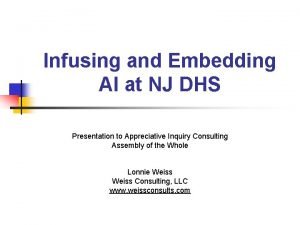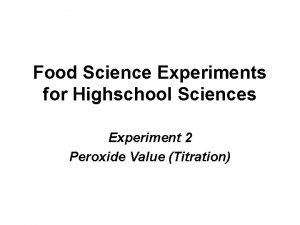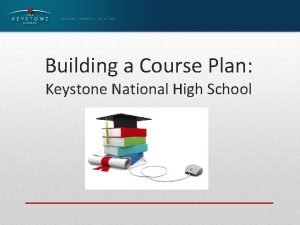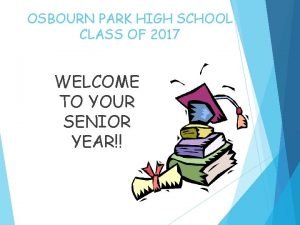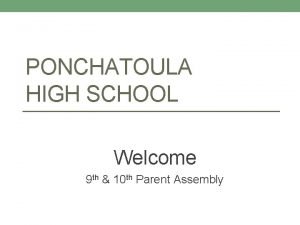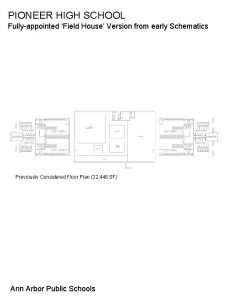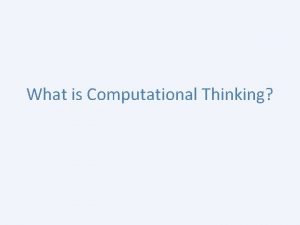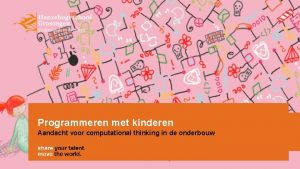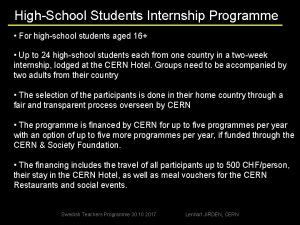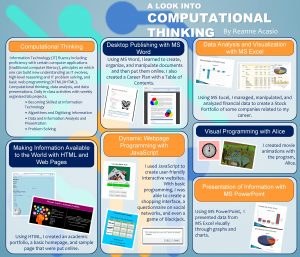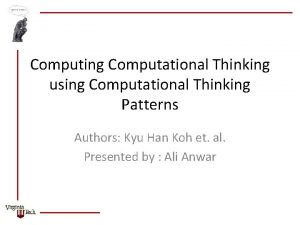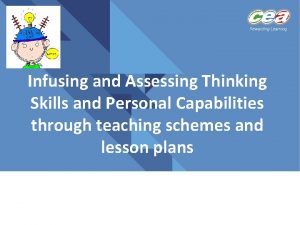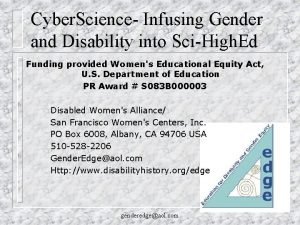Infusing Computational Thinking into the Middle and HighSchool












- Slides: 12

Infusing Computational Thinking into the Middle- and High-School Curriculum Amber Settle De. Paul University 17 th Annual Conference on Innovation and Technology in Computer Science Education (ITi. CSE): July 3, 2012 Joint work with Baker Franke, Ruth Hansen, Frances Spaltro, Cynthia Jurisson, Colin Rennert-May, and Brian Wildeman

Computational thinking • What is computational thinking? • “To reading, writing, and arithmetic, we should add computational thinking to every child’s analytical ability” (Wing, 2006) • Computational thinking is “the thought processes involved in formulating problems and their solutions so that the solutions are represented in a form that can be effectively carried out by an information-processing agent. ” (Wing, 2011) • Infusion into the curriculum • Undergraduate: NSF CPATH (CISE Pathways to Revitalized Undergraduate Computing Education) Program • Drawback: Only a minority of people worldwide attend college or university • K-12 curriculum: NSF Computing Education for the 21 st Century (CE 21) Program • Drawback: (In U. S. ) Computer science is not a core topic

CT across the curriculum § Three-year project: 2008 – 2011 § NSF CPATH Program § Denning’s Great Principles of Computing § Computation, communication, coordination, recollection, automation, evaluation, and design (abstraction) § De. Paul University § Liberal Studies Program § Eighteen faculty in eight different departments/schools (including geography, history, art and art history, and anthropology) § Nineteen courses § Extension into K-12 § Research Experience for Teachers (RET) supplement § Six teachers in five departments (computer science, English, fine arts, history, and world languages)

The Lab Schools § The University of Chicago Laboratory Schools § Nursery through 12 th grade § Founded in 1896 § Approximately 1700 students § Ideal environment for experimentation § Private § Selective enrollment § Diverse racial, ethnic, and socio-economic backgrounds § Strong faculty development support § Computer science department with four teachers § Teacher-to-teacher outreach

Courses modified Course Level Grade(s) Ages Computational thinking across the curriculum English High school 10 15 – 16 Graphic arts High school 9 – 12 14 – 18 History High school 11 – 12 16 – 18 Latin High school 10 – 12 15 – 18 Interdisciplinary computational thinking Computer science Middle school 5 10 – 11 Varied pedagogical approaches Computer science High school 9 14 – 15

English § 10 th grade English class § 9 th grade: “Hamlet” and sonnets § Ten-week term: “Romeo and Juliet” § Central focus: Close reading of the text § Word choice, imagery, and syntax § Address a problem § Students make generalizations based on few data points § “Macbeth is the most violent character in the play” (single text) § “Shakespeare’s plays are violent” (multiple texts) § Handling incorrect generalizations § Common: Instructor correction, directly or by asking for support § Better: Provide a method for testing hypotheses § Encourages broad thinking about texts

English § Method: Digital text analysis tools 1. 2. 3. Form or identify intuitions Hypothesize results – What results would confirm/deny your claims? Apply the tool(s) § TAPor (http: //portal. tapor. ca) § Tag. Crowd (http: //tagcrowd. com) 4. 5. Analyze results and assess the intuition Form conclusions § Three phases: Instructor demonstration, in-class group work, individual assignment § Types of CT § Abstraction: Distill ideas from text § Evaluation: Connect intuition and hypothesis; Assess results

History § 11 th and 12 th grade American history § Required, year-long course § Build a skill: Effective note taking § Not a passive activity § Include diverse information § Teacher comments § Student comments/questions § Allow easy recall of detailed information § Technique: Use hashtags while note taking § Types of CT: § Abstraction: Identify appropriate tags § Evaluation/Recollection: Consider effectiveness of tags

History 1. Formal presentation on note taking 2. Introduce hashtagging § Thoughtful abstraction § No proper nouns or words from lecture 3. Short, formal lecture for practice § Instructor: Identify hash tags in advance § Students: Note taking + in-class work (identification of hashtags + group evaluation + summary report) 4. Longer, formal lecture § Instructor: Identify hash tags in advance § Students: Note taking + at-home assignment (identification of hashtags) + in-class work (group evaluation)

Graphic arts § Digital Design for Communication § Year-long graphic design class § Grades 9 – 12 § New project: Design a prototype for a 3 D object § Aspects of the unit: § § Understand designer/client relationship Explore prototypes Experience design team dynamics Learn 3 D modeling software § One-month duration § Types of CT: § Abstraction: Graphic reduction § Communication: Necessity of precision

Graphic arts 1. Introduction to prototypes § Ideas for objects § Simple sketches and critique 2. Introduce Google’s Sketchup software § Practice sessions 3. Implement prototypes § Trade sketches with each other § No communication about sketches § Implement using Sketchup 4. (Optional) Introduction to package design 5. Compare sketches and 3 D prototypes

Thanks § Acknowledgements § National Science Foundation § Grant number 0829671 § CT across the Curriculum § Co-PI: Ljubomir Perković § More information § Amber Settle, asettle@cdm. depaul. edu § http: //compthink. cs. depaul. edu/ § Questions?
 Destiny 2 infusing
Destiny 2 infusing Computational thinking algorithms and programming
Computational thinking algorithms and programming Using mathematics and computational thinking
Using mathematics and computational thinking Science experiments for highschool
Science experiments for highschool Keystone national highschool
Keystone national highschool Osbourn park high school ranking
Osbourn park high school ranking Ice cube high school
Ice cube high school Ponchatoula highschool football
Ponchatoula highschool football Vita highschool vita
Vita highschool vita Skyline high school floor plan
Skyline high school floor plan Characteristics of computational thinking
Characteristics of computational thinking Computational thinking flowchart
Computational thinking flowchart Leerlijn computational thinking
Leerlijn computational thinking
